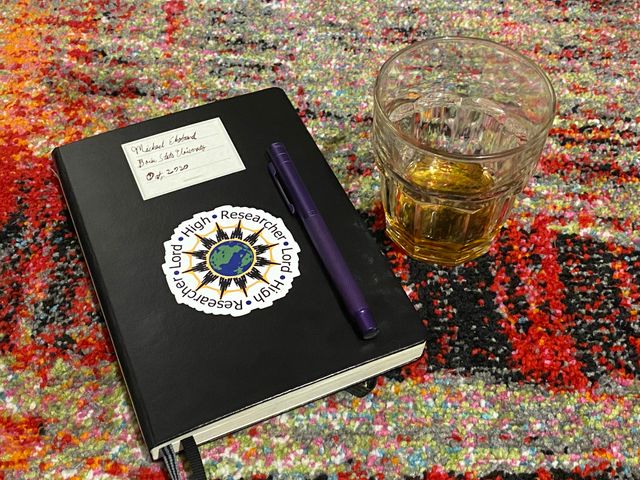Ritual

Ritual is a powerful tool for navigating life. David Allen, in Getting Things Done, promotes a weekly review to take stock of your current Next Action lists, identify projects that need to be moved up (or down) the stack, and plan what’s next.
Regular rituals are an important part of my work management, linking together my notebook, runway, and self-care. My particular practices are modeled most closely after the tactical practices of implementing Michael Linenberger’s One Minute To-Do List on paper.
The Week

The most central of my rituals is on Sunday evenings. I make a practice of not working on Sundays; in the morning we go (or “go”, during COVID) to church, and in the afternoon I relax, often with a video game.
Sunday evening I begin to prepare for the next week. I fetch my notebook and my pens, typically pour myself a whiskey (tonight I’m drinking a bourbon from Wyoming Whiskey), and reflect on what I need to do the next week. If I’ve been able to rest over the weekend, my mind is starting to think of the next week’s work, and committing those thoughts to paper helps me put them aside (“this is for tomorrow, and it’s written down so I won’t forget”) and start the week with better rest; if I haven’t, it helps me get mentally ready for the week ahead.
I use this time to fill out my Weekly Plan and the (initial) To-Do and Scheduled sections of my Daily Log for Monday (see my notebook description for more details on what these contain). I consult both my calendar and my runway when planning this, to see if there are things coming up that I need to touch this week, if only to check on their status. This practice helps me contain my thoughts, and makes it easier to go to sleep Sunday night knowing that I’ve written down the things I remembered over the weekend that I should do, and I have a plan of action to begin the week. If I don’t make my plans on Sunday, it’s easy to lie awake pondering the things I need to do. Monday morning, I can wake up and meet the day.
Daily To-Dos
I operate day-to-day with a Daily Log. Before beginning the day’s work (or occasionally after a first-thing meeting), I write down my schedule and a set of Desired Outcomes for the day. The details of this ritual are a little more variable; it’s usually in the morning, but I also commonly do it as I wrap up work the day before. The day before option is often helpful when I’m feeling behind, as making a plan for the next day’s work makes it easier to call today’s work done.
Re-Copying Lists
In both my daily and weekly work planning, I am regularly writing down the same items, either because they are recurring, or because they didn’t get done the first time. This physical act of copying them, as noted by Bob Greenberg, helps me feel connected to my work, and forces a regular implicit review of what exactly it is that I’m trying to do.
I’ve used various digital to-do lists, including the rather flexible auto-prioritization logic of TaskWarrior, and for me, nothing beats regular, tangible contact with my workload.
Longer-Term Rituals
At the beginning of each semester, I take stock of what my goals are for the term, what I hope to accomplish for myself and my students. I review and update my runway, breaking out the new term’s months if needed and assessing the planned and committed work.
I used to do annual plans as well, but with the runway giving me a continuous big-picture view, the semester plans seem adequate to the role the annual review used to serve. For a few years, I had a practice of writing a blog post at the end of the year summarizing what I had accomplished with links to public outcomes (see e.g. 2018); I may resume this practice in the future.
Conclusion
Regular, often physical, contact with my workload helps me keep on top of what I need to do. It also helps my mental and emotional health, as planned times to review my work and plan the next week let me offload things occupying (anxious) brain cycles and rest soundly in the knowledge that they’re captured in a form more reliable than neurons. When I’m feeling particularly underwater, the act of writing down what I need to do helps me find my way out and think, concretely, about what to do next.
Different things will work for different people, but I find analog rituals to be crucial and these are ones that work for me at this time in my life. In a year or five I may well be doing something differently. We will see what the future brings.
If you’re feeling completely overwhelmed and having difficulty planning your way through the next day, I found One Minute To-Do List helpful in that situation — it starts with a short analog ritual, and provides useful tactics for taking back some control of your workload.